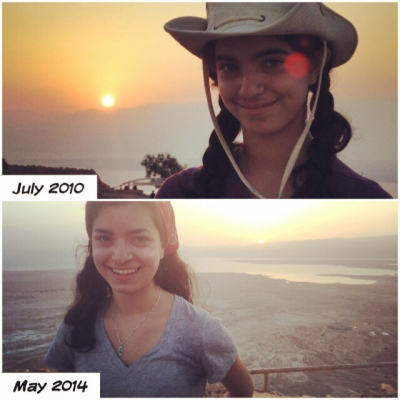A Foot on Masada
Upon our arrival at the Ein Gedi hostel and after we’d had dinner, our group promptly went to sleep as the alarms would sound at three in the morning so we could get on the bus to take us to the foot of Masada. We arrived at the site after four a.m. and climbed the fortress in order to be able to see the sunrise over the Dead Sea. I had already climbed the fortress before, however this time it seemed to take much longer and be much more difficult (definitely the most physically exhausting thing I had done in a very long time). I was later told that we had actually climbed up the “snake path” and not the ramp that the Romans had built to lay siege on the fortress. Trying to pace myself zig-zagging in the almost total darkness, I kept telling myself not to look up too frequently only to see how much further I had to climb, and tried to remind myself how the invading Romans must have done something very similar in heavy armour. Once I had finally made it up to the top, completely exhausted, I was excited to see the rest of the group there, waiting for the sun to rise. It was a really beautiful experience, and it was hilarious to take part in cheering on Helios/Apollo with the rest of the group as the sun steadily crept up over the horizon.We played charades and napped, waiting for two hours for the rest of our group who rode up in the cable car to join us.

Josephus writes about Masada in his account of the Jewish war. He is the ancient source available and is traditionally seen as giving the historic account. After the revolts in Jerusalem the zealots take over the fortress at Masada, which had been built as Herod’s palace on a mountain in the middle of the desert. There, the people have the heroic act of self-sacrifice. It is very poetically described how the men kissed their wives and children and how the people would rather “die free than live as slaves.” After his own capture at the siege of Jotapata, Josephus gives himself over to the Romans instead of participating in mass suicide himself (as he describes happened at Masada). He takes on the name Flavius as he is now part of that household and becomes the official historian of the Jewish war for the Flavian dynasty, writing for the Romans—to his own people he would have been flagged as a traitor.
There is hardly any archaeological evidence for the event as Josephus describes it; Shaye Cohen details how the human and structural remains are not to the scale as detailed by the ancient historian. Some archaeological finds point to clues that could be plausible, while others completely contradict it. However, the account itself has a lack of clarity in its unreliable narration. Josephus was not at the siege at Masada, his sources are survivors who apparently hid at the mass suicide—it was also traditional in the telling of contemporary history to exaggerate the drama of these types of accounts.
The story of Masada as told by Josephus becomes mythologized. The Jews are presented as noble people who wanted freedom so much that they died for it; this is something the Romans would have respected. This theme of dying for one’s freedom is what fueled uprisings such as the Warsaw ghetto and is quite the model for modern Israel and Zionism, shaping Jewish identity. This makes the site extremely popular for Zionist groups (like the one I went on myself four summers ago) and others. Even though there is little archaeological evidence for the event Masada is well known for, anyone can appreciate the fortress itself, and how King Herod’s builders made the desert habitable.
Natalia Pochtaruk.
